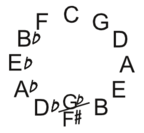Modulation is a shifting of key-center (the tonic), or “the key.” A semitone alteration upward at diatonic degree 4 (whether by sharping or by removing a flat) makes the diatonic pattern reappear with a different tonic–a new key, the dominant of the old key. For example, this changes the key of C major to G major, or B-flat major to F major.
Altering degree 7 downward by a semitone (by removing a sharp or by flatting) re-forms the diatonic pattern with a different new tonic, the subdominant of the old key. For example, this changes the key of A major to D major, or B-flat major to E-flat major.

On the Squiggle page a pattern-generalized explanation (without key name examples) shows how the same diatonic pattern re-forms on first-degree modulation. The Circle of Fifths (Clock of Dominants) is a practical way of schematizing progress through the keys by first-degree modulation, in either direction: clockwise through successive dominant keys, counter-clockwise through subdominant keys.
— “Slantnote” (David Zethmayr) 2 December 2011 (MST)